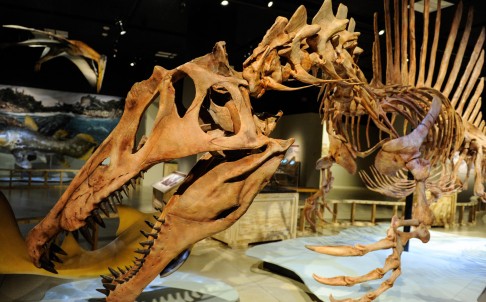Massive Spinosaurus aegyptiacus believed to have lived in the oceans
Fossil evidence shows Spinosaurus was largest predatory dinosaur, putting T.rex in the shade
PUBLISHED : Friday, 12 September, 2014, 9:05pm
UPDATED : Saturday, 13 September, 2014, 3:23am
The Washington Post

A model of Spinosaurus, a semi-aquatic dinosaur, in Washington. It was nearly three metres longer than the largest T.rex. Photo: Xinhua
Scientists have long known there were marine reptiles prowling the seas, but they couldn't find fossils that put dinosaurs in the water.
Now, fossil evidence published on Thursday in Science magazine changes that, and the Spinosaurus aegyptiacus is breaking records. It is now the largest predatory dinosaur known, three metres longer than the largest Tyrannosaurus rex.
But more importantly, Spinosaurus also provides evidence for a semi-aquatic dinosaur.
Spinosaurus was discovered in the Sahara more than a century ago by German palaeontologist Ernst Freiherr Stromer von Reichenbach, but his fossils were lost in the second world war.
When a partial skeleton was uncovered in the Moroccan Sahara, scientists had a new clue that there was something about the massive creature.
In addition to revealing a record-breaking length, digital modelling of the skeleton suggested aquatic adaptations.
Tiny nostrils back on the middle of the dinosaur's skull presumably allowed it to breathe as it swam at the surface. It also had openings at the end of its snout reminiscent of ones in crocodiles and alligators. In the modern animals, these openings house receptors that let them sense movement in the water.
Huge, slanted, interlocking teeth seem perfectly shaped to catch fish, and hook-like claws would have been ideal for holding slippery prey under water.
Big, flat feet, perhaps even webbed, would have been well-suited to paddling water or treading through m&d, and some unusually dense limb bones (more like those seen in penguins than those found in other dinosaurs, the researchers report) would have allowed it to keep itself under the water, instead of floating.
The dinosaur's skeletal shape indicates that it would have been a strange sight on land. The Spinosaurus' centre of gravity was pushed forward by its long neck, so it was almost certainly impossible for it to walk on two legs. Its legs and pelvis are quite like those seen in early whales and much better for paddling than for walking.
Like whales, these dinosaurs probably evolved from land-dwelling ancestors to become semi-aquatic.
Scientists aren't quite sure how Spinosaurus moved when it left the water, which it must have done to lay and nest eggs. Spinosaurus didn't have the kind of limbs that scientists would expect in a four-legged animal, but it also couldn't have balanced on its hind legs for long. The 2001 movie Jurassic Park III features a scene in which a Spinosaurus attacks a Tyrannosaurus rex and snaps the legendary carnivore's neck.
"I think that we have to face the fact that the Jurassic Park folks have to go back to the drawing board on Spinosaurus," co-author and University of Chicago palaeontologist Paul Sereno said in a teleconference held by Science this week. "It was not a balancing, two-legged animal on land. It would have been something very peculiar."
This isn't to say that Spinosaurus wouldn't have been an impressive sight on land.
"It would have been a fearsome animal. There's no question about it, you would not want to meet this animal on land," Sereno said. "But it was not gallivanting across the landscape."
While palaeontologists continue to puzzle over how the Spinosaurus managed to walk, a life-size skeletal replica of the creature goes on show today at the National Geographic Museum in Washington.
Additional reporting by Agence France-Presse
